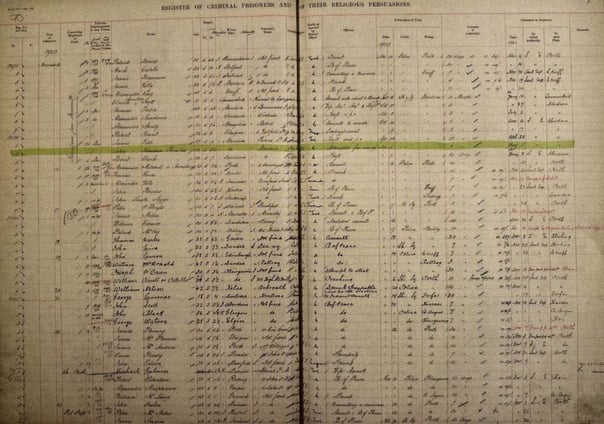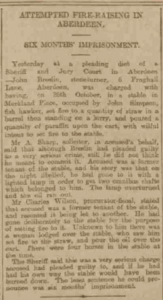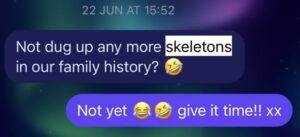Not too long ago, I shared my experience of joining American Ancestors’ recent Scottish Heritage Tour. In that post I briefly introduced you to an intriguing ancestor of mine—John Lynch Breslin, Jr., who was imprisoned for attempted arson. Today I want to discuss how I discovered him, how I learned more about his story, and how I went about emotionally confronting such a noteworthy skeleton in my family’s closet.
 My Ancestor John Lynch Breslin Jr's entry in the Perth prison records (Aberdeen prison records were detailed in Perth's books).
My Ancestor John Lynch Breslin Jr's entry in the Perth prison records (Aberdeen prison records were detailed in Perth's books).
It is important to acknowledge that understanding Scottish records is relatively straightforward, particularly from the 1800s onwards. Records are organized in a clear and manageable manner, including information such as register number, sex, admission date, prosecuting court, previous incarcerations, name, age, height, birthplace, current residence, occupation, health status, committed offence, trial date, conviction sentence, and release date. This absolute wealth of information can provide a comprehensive view of an individual—the depth of which I struggle to match for the non-criminal members of my family tree, which unfortunately includes many individuals who are remembered only by a series of names and dates.
I stumbled upon John Lynch Breslin, Jr.’s name in a prison register while browsing the databases of Scotland’s People Centre. To my astonishment, his home address details perfectly aligned with those of his siblings who were listed in my tree, and his date of birth was an exact match. He was indeed my relative! And just like that, I had uncovered a burned skeleton—one with charred bones, slightly nerve-racking to pull out of the closet. I printed off the document at the centre and marked his entry with a bright green highlighter.
In November of 1903, John Lynch Breslin, Jr. stood trial for attempted arson and was sentenced to six months in Aberdeen prison for his crime. He never reappeared in the prison register after that incident. Six months seemed like a relatively long sentence for attempted arson, prompting me to dig deeper into his story—not only regarding the specifics of his crime, but also the broader context of fire-related crimes in Britain.
Historically, fire-starting has always been a major offense in Britain. Prior to 1887, deliberately setting a fire, especially when damage was caused, was often treated more severely than murder. Considering the relatively limited land area of Great Britain—England, Scotland, and Wales total around 81,000 square miles (roughly the size of Oregon)—the value of land and the potential for extensive damage made arson a grave crime. For the most serious cases, the penalty was death. Fortunately for my ancestor, he attempted his crime 16 years after these laws were revised.
This led me down the rabbit hole of examining the details of John’s crime—what had he done to earn this charge, and how serious was it?
 Article published in the Aberdeen Press and Journal on the 6th of November 1903, detailing John Lynch Breslin’s court trial.
Article published in the Aberdeen Press and Journal on the 6th of November 1903, detailing John Lynch Breslin’s court trial.
Around four weeks after the tour ended, I managed to locate a newspaper article detailing his criminal offense, published a day after his trial. According to the article, he had been a former tenant of the stable he attempted to set ablaze and was infuriated that it was being leased to someone else. He placed straw in a barrel, poured paraffin inside, and tried to ignite it.
My perception of the situation shifted drastically from intrigue to horror upon reading the following lines in the article:
"Unbeknownst to him, a woman lodged over the stable witnessed him setting fire to the straw and dousing the cart with oil. Four horses were in the stable at the time."
Suddenly, six months didn't seem like a substantial punishment for someone who had endangered five lives. The sheriff reportedly noted that if the woman hadn't been awake, the stable would have been consumed. The sentence he received was the shortest available.
Discovering John Lynch Breslin and his story was a genealogical adventure unlike any I had ever undertaken before. I kept my family updated about every step of my journey as details gradually emerged. I consider myself fortunate that a wide range of responses have come my way—from horror to intrigue, curiosity to amusement, I’ve seen it all. Thankfully, not one member of my family expressed upset at me for revealing this charred skeleton in our family’s past. Instead, they’ve shown genuine interest in how such a significant piece of our history could remain concealed for so long.
As for me, it provided me insight into dealing with less pleasant information in your family history. At the end of the day, as Jan Doerr wrote on this topic in 2016, these are not our burdens to bear—good or bad, our ancestors do not make us who we are. Moreover, finding out about John’s criminality allowed me to see him as a more nuanced individual—a shade of grey in amongst the black-and-white rows of names and dates.
Shortly after I found his original report in the prison records, my mother messaged me: “Not dug up any more skeletons in our family history?”
I suppose my answer to that question remains the same, even after closing John’s chapter of my genealogical journey: “Not yet. Give it time!!”
